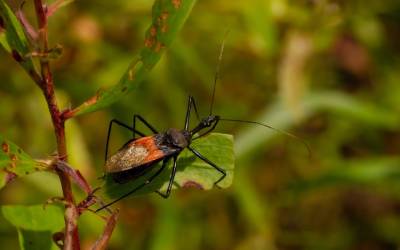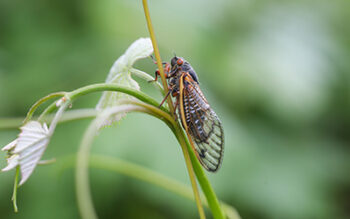
Hi, is this the insect-naming department? Yeah, I need to speak to the person in charge. Who came up with the name ‘kissing bug’? I mean, seriously, who do I need to talk to about this? It sounds like a harmless little creature, like a ladybug or a butterfly. But no, these things bite peoples’ faces and spread disease. Though their natural habitats are Central and South America, you may have heard reports that kissing bugs are expanding their range into the United States. Do we need to take kissing bugs seriously as a threat? Just how dangerous are kissing bugs?
Where Are Kissing Bugs Found?
They’re fairly common in Central and South American, where there are 130+ species of the Triatominae family, called kissing bugs, or perhaps more appropriately, vampire bugs, cone-nosed bugs, or assassin bugs.
Arkansans need to know about kissing bugs because they have been spotted in our state. They’re still rare here, but their range has been expanding year by year. As of the time of this writing, there have been confirmed sightings in 32 U.S. states as far north as Nebraska and Pennsylvania. Texas and California have hotspots.
Kissing bugs can live indoors or out. They tend to prefer cracks or crevices, places like wood piles, or under porches. Every Triatominae species has the potential to transmit the T. cruzi parasite to humans, which is why it’s important to know about them.
What Is Chagas Disease?
Dr. Carlos Chagas of Brazil first described symptoms caused by the T. cruzi parasite in 1909. Today, it’s estimated that the parasitic infection that’s come to be known as Chagas disease affects more than 6 million people worldwide with 150,000-200,000 new infections each year. Most infections are contracted in tropical regions where kissing bugs are common, but as we mentioned earlier, any Triatominae species is a potential carrier of the T. cruzi parasite.
The acute stage of Chagas disease occurs on average one week after the bite. Symptoms are often minor, and usually include headache, fever, and malaise. Occasionally there are no symptoms. Very rarely there are severe acute symptoms which can include heart inflammation or brain inflammation along with headache and fever. Seek immediate medical attention if you feel very sick following a possible kissing bug bite.
Should You See a Doctor for Chagas Disease?
Yes. If you have been exposed to the T. cruzi parasite that causes Chagas disease, it’s important to get treated, even if symptoms are minor or nonexistent. The reason is simple.
Individuals whose acute Chagas goes untreated often go on to develop the chronic form of the disease. The chronic phase of Chagas can take 10 to 30 years to develop in an individual, but once it does it’s untreatable. It’s a scourge in places where kissing bugs are endemic, affecting major organ systems including the digestive system and heart, and reducing both quality of life and life expectancy in affected individuals.
Chagas disease infections are rare in the United States, but if you believe you have a kissing bug bite, see a doctor immediately. Doctors can prescribe antiparasitic drugs that prevent the onset of chronic Chagas disease.
Anaphylaxis
Although Chagas disease is the primary concern with Kissing Bugs, for a very small proportion of people there is one other concerning possibility. Individuals with severe allergies may have sensitivities to Kissing Bug bites and/or feces. This can lead to anaphylactic reactions that cause breathing difficulties and throat closure.
Anyone with reason to believe they might be suffering from an anaphylactic reaction should seek immediate emergency medical attention.
What Should You Do If You See a Kissing Bug?
Kissing bugs are rare and can easily resemble other common insects like stink bugs. If you’re sure it’s a kissing bug, call a professional exterminator to take a look. The pest pros at Delta Pest Control can tell you exactly what you’re dealing with, and inspect the property to see if there are more.
If you spot a kissing bug, report your sighting to Texas A&M University’s Kissing Bugs & Chagas Disease in the United States Community Science Project.




